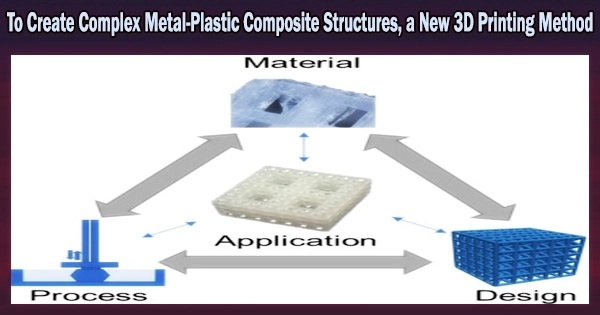There are numerous potential applications for three-dimensional (3D) metal-plastic composite materials in smart electronics, micro/nanosensing, internet-of-things (IoT) gadgets, and even quantum computing.
These structures give designers more creative freedom and allow for the creation of increasingly smaller, more intricately shaped, and complexly featured devices. However, the technologies used to create such parts today are pricy and difficult.
A team of scientists from Singapore and Japan have created the multimaterial digital light processing 3D printing (MM-DLP3DP) technique to create metal-plastic composite structures with arbitrary complicated geometries.
Explaining the motivation behind the study, lead authors Professor Shinjiro Umezu, Mr. Kewei Song from Waseda University, and Professor Hirotaka Sato from Nanyang Technological University, Singapore state, “Robots and IoT devices are evolving at a lightning pace. Thus, the technology to manufacture them must evolve as well. Although existing technology can manufacture 3D circuits, stacking flat circuits is still an active area of research. We wanted to address this issue to create highly functional devices to promote the progress and development of human society.” The study has been published in ACS Applied Materials & Interfaces.
The first phase in the multi-step MM-DLP3DP process is the synthesis of the active precursor chemicals that can be transformed into the required chemical after 3D printing, as the desired chemical cannot be 3D printed itself.
To create the active precursors in this instance, palladium ions are added to light-cured resins. This is done to support electroless plating, which is the process of forming a metal coating by the auto-catalytic reduction of metal ions in an aqueous solution.
Robots and IoT devices are evolving at a lightning pace. Thus, the technology to manufacture them must evolve as well. Although existing technology can manufacture 3D circuits, stacking flat circuits is still an active area of research. We wanted to address this issue to create highly functional devices to promote the progress and development of human society.
Professor Shinjiro Umezu, Mr. Kewei Song, and Professor Hirotaka Sato
The next step is to create microstructures with nested sections of the resin or active precursor using the MM-DL3DP equipment. Finally, these materials are directly plated, and ELP is used to add 3D metal designs to them.
To show the manufacturing potential of the suggested technique, the research team produced a range of parts with complex topologies. These components featured intricate designs with multimaterial nested layers, microporous surfaces, and teeny-tiny hollow structures, the smallest of which was 40 m in length.
Additionally, the metal patterns on these components were extremely exact and controllable. The group also created 3D circuit boards with intricate metal topologies, such as a nickel-based LED stereo circuit and a copper-based double-sided 3D circuit.
“Using the MM-DLP3DP process, arbitrarily complex metal-plastic 3D parts having specific metal patterns can be fabricated. Furthermore, selectively inducing metal deposition using active precursors can provide higher-quality metal coatings. Together, these factors can contribute to the development of highly integrated and customizable 3D microelectronics,” Umezu, Song, and Sato state.
The novel manufacturing method has applications in a wide range of technologies, including 3D electronics, metamaterials, flexible wearables, and metal hollow electrodes. It is expected to be a breakthrough technology for the production of circuits.





